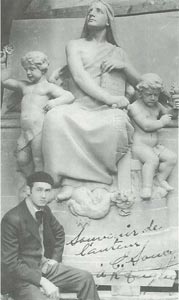
Rodolphe Duguay, 1925
BIOGRAPHY
Rodolphe Duguay was born at Nicolet, in Québec in 1891. From a poor, rural environment, he began his studies with Alfred Laliberté and J.C. Franchère at Council of Arts and Manufactures in Montreal between 1911 and 1920, with William Brymner at the Art Association of Montreal in 1915-16 and with Maurice Cullen in 1917. He became familiar with the tradition established in French Canada by artist such as Suzor-Coté with whom he worked in 1918-20.
From 1920 until 1927, he stayed in Paris, studied at the Académie Julian in 1920-24, at the Académie Colarossi and Académie Adler in 1924. He travelled around Europe, in Brittany, Normandy and Italy.
He learned in 1925 the techniques of wood engraving. It was in this medium that Duguay achieved his most original expression, in illustrating the texts of his wife, Jeanne L'Archevêque-Duguay (Écrin, 1934; Cantilènes, 1936; Offrande, 1942), as well as those of many other writers, including Clément Marchand (Courrier des villages, 1941). In 1935, encouraged by Mgr. Albert Tessier of Trois-Rivières, he began the publication of two series of wood engravings that made his work more widely known. He died in Nicolet in1973.His Carnets intimes, covering his activities in Europe, were published in 1978.
SUBJECT / THEMES
Duguay's work expresses a profound religious message based on goodness, innocence, purity and suffering.
TECHNIQUE/MEDIUM
Rodolphe Duguay was a painter, engraver, illustrator.
COLLECTIONS
Various exhibitions at the National Gallery of Canada (1975), the Musée du Québec (1977) and Nicolet (1991) showed his engravings and paintings as part of the slow movement toward modern art expression in Québec.
Source: Canadian Encyclopedia and Catalogue of The National Gallery of Canada, Canadian art, volume one/A-F, Ottawa, 1998